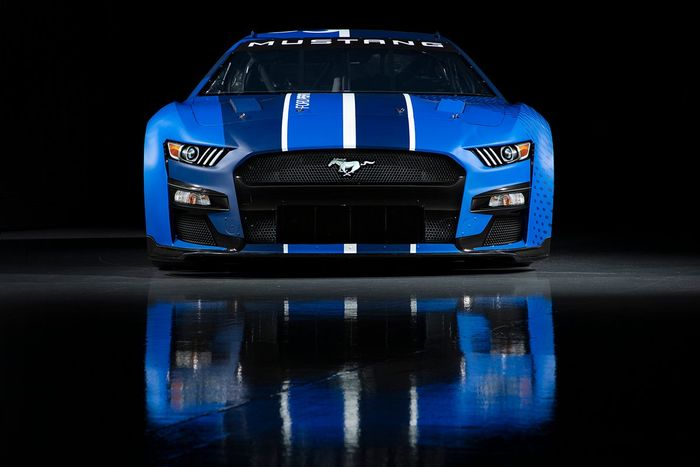Toyota: NASCAR’s Next Gen is “biggest change” in 50 years
Toyota Racing president David Wilson believes NASCAR’s Next Gen car, of which the three competing manufacturers all revealed their models today, is the “biggest change for the NASCAR industry” for over 50 years.
Along with Chevrolet and Ford, Toyota revealed its 2022 Next Gen Cup Series car – now called the TRD Camry – on Wednesday.
It features a standardized chassis, which means teams will no longer fabricate their own cars from scratch – or buy them from others via technical alliances – but purchase the tubular frame chassis direct from NASCAR’s appointed builder Technique Chassis, which is designed by single-spec car-building specialists Dallara.
“Year over year, this is the biggest change for the NASCAR industry, in terms of the car that we race, that we have seen cumulatively for over 50 years,” said Wilson. “This is a complete and total tear-up, save the drivers’ seat, so it’s going to be quite the ride next year.
“From Toyota’s perspective, we’re excited about it – this has been a long time coming.”
In another development, Motorsport Games confirmed today that it will bring rFactor2 physics to the upcoming reboot of NASCAR's console video games. Via Studio 397, the Netherlands-based developer will bring its expertise in vehicle physics, tire modeling and AI to the future NASCAR game franchise that will coincide with the Next Gen era.
Wilson explained the previous scenario for its NASCAR Gen-6 car build – where “steel rod tubing goes into one end of Joe Gibbs Racing and racecars come out the other” – will end later this season. Next year, all chassis will be identical and some 30 more single-source companies will supply teams with common components that will require assembly but cannot be modified.
“This new model is a revolutionary change,” he said. “It’s somewhat akin to what IndyCar is today, to use a motorsport-related analogy. It’s a game-changer, no question about that.”
Gallery: Toyota's new Next Gen TRD Camry
Next Gen is the latest step in NASCAR mandating a reduced number of cars for teams to use per season – teams are currently restricted to 12 active chassis per season, with four alternates allowed to be rotated in. But, in previous years, the number of cars that teams used was basically unlimited.
“NASCAR has instructed a maximum of seven cars per team, that is versus what has been historically unlimited,” added Wilson. “That’s significant, and the savings are more going to be a function of the car being ‘standardized’ – we don’t like to use the word ‘spec’ – but let me put it this way, there’s 30-plus single-source suppliers where teams will be buying most of their car from, and they can’t touch the parts after they purchase them, for the most part.
“What that does for the organizations is that it eliminates the necessity to have very large fabrication and manufacturing operations.”
Gallery: Ford's new Next Gen Mustang
Toyota Racing Development’s executive engineering technical director, Andy Graves, outlined another seismic shift regarding the eradication of asymmetrical bodies – that made previous generations of NASCAR appear to ‘crab’ in a straight line.
“The car is symmetrical, left to right, which we’ve not had in NASCAR since we started testing in windtunnels and realized it was an advantage to skew the back of the car to the right for extra side-force,” said Graves. “This is now mandated, so we’ve been able to put a lot more detail into the sides and rear of the car.
“With the current Gen-6, if you look at the drivers’ side versus the passenger side, the back half of the door and quarter panels are quite a bit different just because of that two-and-a-quarter inches of offset.
“The car has a steering rack that’s very much similar to the production vehicles and 18-inch aluminum wheels which really helps the styling of the car. The attributes that we were able to incorporate is the closest to production Camry that we’ve ever had.”
Gallery: Chevrolet's new Next Gen Camaro ZL1
Wilson also confirmed that engine architecture would be the next long-term project on NASCAR’s cost-saving hit-list, although the current V8s would be retained in the foreseeable future – likely with some form of hybrid power assistance in 2023.
Technical specifications for Next Gen 2022 Toyota TRD Camry:
- Overall Length: 193.3”
- Overall Height: 50.2”
- Width: 78.4”
- Wheelbase: 110”
- Power: 670 hp or 550 hp (track dependent)
- Transmission: 5-speed sequential shift
Toyota TRD Camry Next Gen vs. Current NCS Toyota Camry features
- New 18" forged aluminum wheels
- A new transaxle will combine the transmission and rear gears into one package
- Independent rear suspension
- The bottom of the car will be sealed with a full underbody and rear diffuser
- A redesigned chassis features new front and rear bumpers. Both the front and rear clips bolt on to the center section of the vehicle
- Composite body and symmetrical car
- Engine intake from the grille area with a new longer airbox
- Hood exits incorporated to assist with engine cooling
Be part of Motorsport community
Join the conversationShare Or Save This Story
Related video
Subscribe and access Motorsport.com with your ad-blocker.
From Formula 1 to MotoGP we report straight from the paddock because we love our sport, just like you. In order to keep delivering our expert journalism, our website uses advertising. Still, we want to give you the opportunity to enjoy an ad-free and tracker-free website and to continue using your adblocker.





























Top Comments